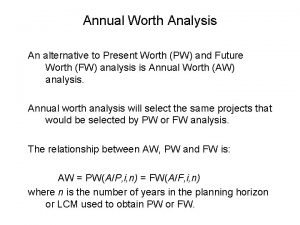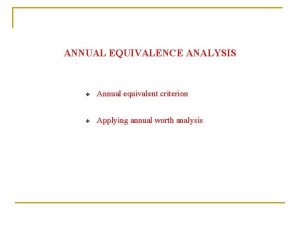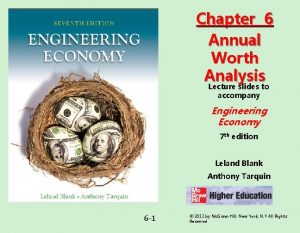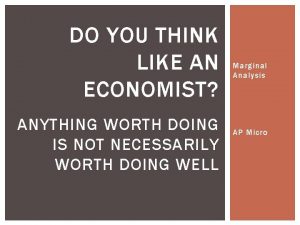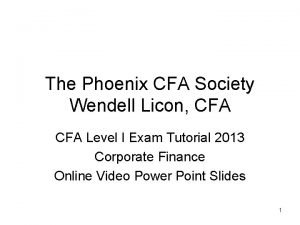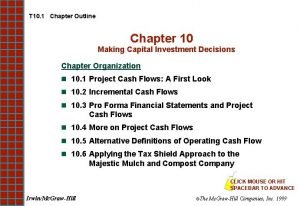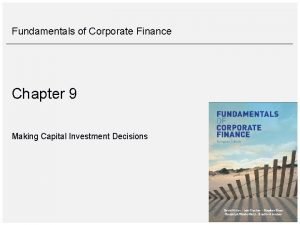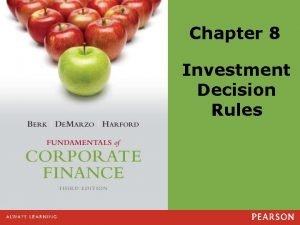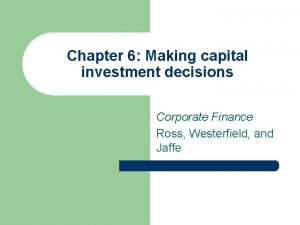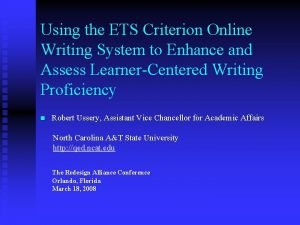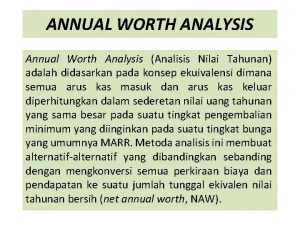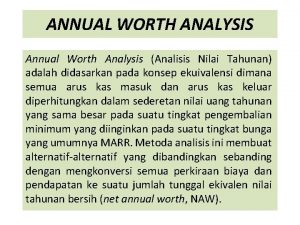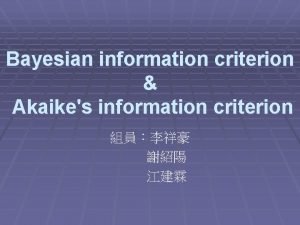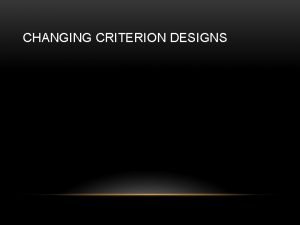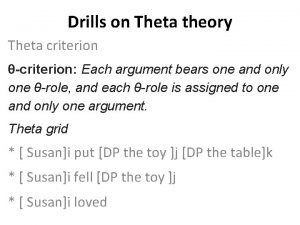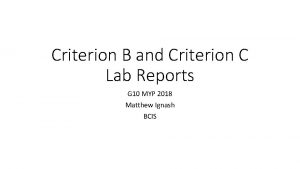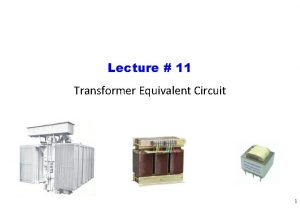Annual Equivalent Worth Criterion Lecture No 19 Chapter
















- Slides: 16

Annual Equivalent Worth Criterion Lecture No. 19 Chapter 6 Contemporary Engineering Economics Copyright © 2016 Contemporary Engineering Economics, 6 th edition Park Copyright © 2016 by Pearson Education, Inc. All Rights Reserved

Chapter Opening Story: Robots May Revolutionize China’s Electronics Manufacturing o Cost of a robot: $10, 000 o Planning horizon: 20 years o Cost of operating and owning the robot per year? Issue: Replacing people with robots would reduce the operating cost at the expense of increasing capital cost. Contemporary Engineering Economics, 6 th edition Park Copyright © 2016 by Pearson Education, Inc. All Rights Reserved

Annual Worth Analysis • Annual Equivalent Conversion q. Principle: Measure an investment’s worth on an annual basis. q. Benefits: By knowing the annual equivalent worth, we can: o. Seek consistency of report format. o. Determine the unit cost (or unit profit). o. Facilitate the unequal project life comparison. Contemporary Engineering Economics, 6 th edition Park Copyright © 2016 by Pearson Education, Inc. All Rights Reserved

Fundamental Decision Rules For Single Project: • If AE(i) > 0, accept the investment. • If AE(i) = 0, remain indifferent to the investment. • If AE(i) < 0, reject the investment. Contemporary Engineering Economics, 6 th edition Park For Mutually Exclusive Alternatives: • Service projects: Select the alternative with the minimum annual equivalent cost (AEC). • Revenue projects: Select the alternative with the maximum AE(i). Copyright © 2016 by Pearson Education, Inc. All Rights Reserved

Example 6. 1: Economics of Installing a Feed-water Heater • Install a 150 MW unit • Initial cost = $1, 650, 000 • Service life = 25 years • Salvage value = 0 • Expected improvement in fuel efficiency = 1% • Fuel cost = $0. 05 k. Wh • Load factor = 85% • Determine the annual worth for installing the unit at i = 12%. • If the fuel cost increases at the annual rate of 4%, what is AE(12%)? Contemporary Engineering Economics, 6 th edition Park Copyright © 2016 by Pearson Education, Inc. All Rights Reserved

Solution: Calculation of Annual Fuel Savings • Required input power before adding the second unit Annual Fuel Savings • Required input power after adding the second unit : • Reduction in energy consumption. 272, 727 k. W − 267, 857 k. W = 4, 870 k. W • Annual operating hours Contemporary Engineering Economics, 6 th edition Park Copyright © 2016 by Pearson Education, Inc. All Rights Reserved

Solution: Annual Worth Calculations q (a) with constant fuel price • Cash Flow Diagrams q (b) with escalating fuel price Contemporary Engineering Economics, 6 th edition Park Copyright © 2016 by Pearson Education, Inc. All Rights Reserved

Repeating Cash Flow Cycles • First Cycle • Repeating Cycles Contemporary Engineering Economics, 6 th edition Park Copyright © 2016 by Pearson Education, Inc. All Rights Reserved

Example 6. 3: Comparing Alternatives Contemporary Engineering Economics, 6 th edition Park Copyright © 2016 by Pearson Education, Inc. All Rights Reserved

Solution • Required assumptions • The service life of the selected alternative is required on a continuous basis. • Each alternative will be replaced by an identical asset that has the same costs and performance. • Model A • Model B Contemporary Engineering Economics, 6 th edition Park Copyright © 2016 by Pearson Education, Inc. All Rights Reserved

q. When only costs are involved, the AE method is called the annual equivalent cost (AEC). q. Revenues must cover two kinds of costs: operating costs and capital costs. Annual Equivalent Costs Annual Equivalent Cost (AEC) Capital costs + Operating costs Annual equivalent cost = Capital cost + Operating costs Contemporary Engineering Economics, 6 th edition Park Copyright © 2016 by Pearson Education, Inc. All Rights Reserved

Capital (Ownership) Cost • Def: Owning equipment associated with two transactions—(1) its initial cost (I), and (2) its salvage value (S). • Capital costs: Taking these items into consideration, we calculate the capital costs as: Contemporary Engineering Economics, 6 th edition Park Copyright © 2016 by Pearson Education, Inc. All Rights Reserved

Cost of Owning a Vehicle SEGMENT BEST MODELS ASKING PRICE AFTER 3 YEARS Compact car Mini Cooper $19, 800 $12, 078 Midsize car Volkswagen Passat $28, 872 $15, 013 Sports car Porsche 911 $87, 500 $48, 125 Compact Luxury car BMW 3 Series $39, 257 $20, 806 Luxury car Mercedes CLK $51, 275 $30, 765 Minivan Honda Odyssey $26, 876 $15, 051 Subcompact SUV Honda CR-V $20, 540 $10, 681 Compact SUV Acura MDX $37, 500 $21, 375 Full size SUV Toyota Sequoia $37, 842 $18, 921 Compact truck Toyota Tacoma $21, 200 $10, 812 Full size truck Toyota Tundra $25, 653 $13, 083 Contemporary Engineering Economics, 6 th edition Park Copyright © 2016 by Pearson Education, Inc. All Rights Reserved

Example: Capital Cost (Mini-Cooper) • Capital Recovery Cost q Given: o o I = $19, 800 N = 3 years S = $12, 078 i = 6% q Find: CR(6%) Contemporary Engineering Economics, 6 th edition Park Copyright © 2016 by Pearson Education, Inc. All Rights Reserved

Example 6. 4: Required Annual Revenue • Cost of Owning and Operating q Given: o o I = $20, 000 S = $4, 000 N = 5 years i = 10% q. Find: See if an annual revenue of $5, 000 is large enough to cover both the capital and. operating costs. Contemporary Engineering Economics, 6 th edition Park Copyright © 2016 by Pearson Education, Inc. All Rights Reserved

Solution q. Need additional revenue in the amount of $120. 76 to justify the investment Contemporary Engineering Economics, 6 th edition Park Copyright © 2016 by Pearson Education, Inc. All Rights Reserved
 Present worth to annual worth
Present worth to annual worth Present worth vs annual worth
Present worth vs annual worth Annual equivalent cost
Annual equivalent cost Contoh soal future worth analysis
Contoh soal future worth analysis Rumus present worth analysis
Rumus present worth analysis Annual worth analysis
Annual worth analysis Anything worth doing is not necessarily worth doing well
Anything worth doing is not necessarily worth doing well Degree of financial leverage formula
Degree of financial leverage formula Problem 10-18 calculating eac..
Problem 10-18 calculating eac.. Equivalent annual cost
Equivalent annual cost Equivalent annual annuity
Equivalent annual annuity Equivalent annual cost method
Equivalent annual cost method 01:640:244 lecture notes - lecture 15: plat, idah, farad
01:640:244 lecture notes - lecture 15: plat, idah, farad Management fifteenth edition
Management fifteenth edition Human resource management lecture chapter 1
Human resource management lecture chapter 1 Human resource management lecture chapter 1
Human resource management lecture chapter 1 Ets.criterion
Ets.criterion

